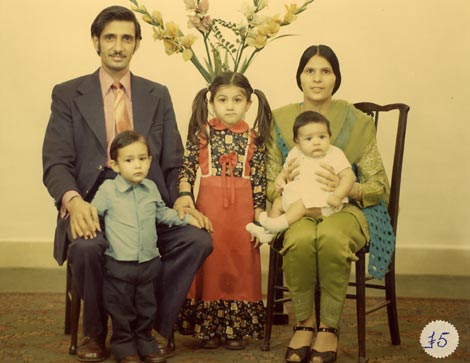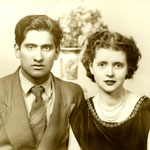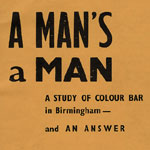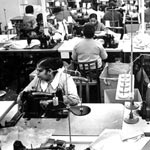
Introduction
Recounting the Past - Voices in the Archives
The Journey to Britain
Expectations of a New Land
Encountering a New Landscape
Introduction
At the end of the Second World War Britain was suffering greatly: the country's industries and service sector needed to be rebuilt in order to boost the economy and provide for its citizens. In order for this rebuilding to take place Britain needed workers. During wartime men and women from the Caribbean islands and South Asia had served in its armed forces and in civilian roles, and the country looked once again to these countries that it had colonised to source a workforce. In 1948 as some of these countries were regaining their independence, the British Nationality Act was passed, conferring British citizenship on those who had previously been colonial subjects, giving them the right to live and work in Britain. The economies of many of the seceded nations were themselves struggling in the aftermath of colonialism and their people, having acquired British citizenship, sought to improve the life chances of their families by emigrating.
Prior to the waves of Commonwealth migration, there were flows of people from Ireland and continental Europe to Britain. Between 1946 and 1951 an estimated 450,000 foreign workers arrived, including approximately 120,000 Poles and 100,000 European Voluntary Workers. Between 1946 and 1951 100,000 people entered from Ireland as many were recruited to work in factories, hospitals and on public transport. Although this constituted a level of immigration which exceeded that from the Commonwealth even at its height in 1961-621 there was little public and political concern compared to that which accompanied the arrival of black people.
Whilst it is not possible to identify the precise number of people who migrated to Birmingham during this period we can get an idea from official figures on the country of origin of Birmingham residents. The table below highlights Birmingham residents from the largest donor countries over the last 50 years.
|
Number of Birmingham Residents
from each country (census data) |
Country of Birth |
1961 |
1971 |
1981 |
1991 |
2001 |
Bangladesh* |
|
|
950 |
7,682 |
10,785 |
India |
4,801 |
17,885 |
22,267 |
21,553 |
23,194 |
Jamaica |
12,017 |
19,385 |
17,371 |
14,256 |
14,207 |
Kenya |
79 |
2,945 |
4,323 |
3,852 |
3,766 |
Pakistan |
5,355 |
17,515 |
24,930 |
31,343 |
41,724 |
Republic of Ireland |
44,798 |
44,865 |
37,375 |
30,392 |
22,828 |
* Prior to the end of 1971, Bangladesh was not an independent country; it was part of Pakistan (named 'East Pakistan').
1 Braham, P (1982) Migration and Settlement in Britain in Migration and Settlement: Open University Press.
<return to top>
Recounting the Past - Voices in the Archives
Many books, reports and articles have provided an analysis of post-war migration to Britain however they dedicate little space to the words of the ordinary people who lived through that crucial time. Oral history- the name given to eye-witness accounts of events from the past - reconstructs the past around the ordinary people who made and experienced history through their own words. The accounts of Birmingham people in the City Archives, extracts of which are presented throughout these pages, express the unique voices of people who made the journey to Britain. In contrast to the impersonal statistics bandied about by politicians and the often biased newspaper articles written about them which presented people as 'colour problems' [Picture Post, 9/6/1956], the previously silenced voices of migrants themselves highlight the human experience of migration and provide an insight into how this period of history was actually lived.
<return to top>
The Journey to Britain
When they set out for Britain in the hope of finding work, most migrants did not intend their stay to be permanent but looked to earn enough money to send back to their families and return there to establish their lives:
"… I came in 1957, October as I said and I left my wife and two children, two daughters and I told them, I said well I’ll be back within two years and all I need is just to find my feet and establish myself and if I have got enough money, come back and, because those days I don’t think anybody was of the opinion they are going to settle down here and make their home and stay permanently so within two years when I feel that I am comfortable enough I will come back." [MS 2255/2/2 p3]
Early Commonwealth migrants tended to be single men who often had greater social mobility in their country of origin than women. Whilst many women did migrate independently, the majority tended to follow their husbands or fiancés after a short period of time.
Networks of friends and family were also an important aspect of the migration experience- many journeys were facilitated by networks which, as well as providing knowledge, were a vital source of contacts for finding lodgings and work. Migration was often a collective effort which was undertaken to benefit whole families; hence relatives would contribute to the cost of the ticket abroad:
"I matriculated when I was about seventeen and it has always been my ambition to study medicine and consequently I decided, I told my mum that I would like to go to England and if I can remember rightly, I think she borrowed the money or I think the family generally made a collection in order to pay for my passage to England." [MS 2255/2/3 p1]
<return to top>
Expectations of a New Land
The image held by many of Britain as a land of opportunity came about as a result of both communications from colleagues, friends and relatives who had already migrated and the encounter with British people in the pre-independence colonial context. From a young age people living in countries formerly under British colonial rule experienced an educational system based upon that used in England which taught them to regard empire as supreme and England as the Mother Country:
"I knew more about Britain then than I knew about Jamaica. I mean the reading books were the same used in the schools in England here. I knew more about the rivers and the cities and the, especially the history which I didn’t like very much, knights and what have you and Lord this and so on and it was foreign to me, I didn’t know what it meant. I couldn’t imagine what it would look like." [MS 2255/2/85 p1]
Some ventured towards a land of fantasy with trepidation; for Mahmood Sultan who travelled from Pakistan, the journey to England represented the fulfilment of a dream:
"… I couldn’t really believe I was really going to England because to go to England used to be the prerogative of rulers, of the Indian subcontinent Rajahs and Maharajahs and Nawabs, an ordinary person like me we could only visit England in our dreams…"
[MS 2255/2/72 p5]
Migration was believed to offer people many opportunities to improve their standard of living and that of their families. Young people in particular were curious and yearned for excitement and adventure in a foreign land. Catherine Laidlaw, who came to Birmingham from southern Ireland in 1965 at the age of 18, was attracted by the lure of city life:
" And I used to think, I’d love to go to England, used to think it was a brilliant place, all them bright lights and there is everything in England, they’ve got everything."
[MS 2255/2/50 p7]
<return to top>
Encountering a New Landscape
Britain's landscape was vastly different to that left behind by many migrants, particularly those from Commonwealth countries. On arrival, those who had travelled from warmer climates were struck by the weather, no matter how well prepared they thought they were. One man from St Kitts who arrived in 1963 as a boy remembers how his warm suit was no match for an English summer:
"Anyway, off on the plane I came, me, my little self and I, you know, 11 years of age right, on this huge plane traveling all this way, in my best suit, you know, which was made of the thickest material that they could think of that was available, but of course I was freezing. You know, when I got off at Heathrow it was like oh! This was July, July, July 65, July 65 and it was so cold." [MS 2255/2/13 p2]
Despite some familiarity with British systems and people in their homelands, as people arrived they found a landscape and culture that was unusual and bewildering. England was a land of strange sights which made it appear almost like another world:
"So I left airport and while I was in London, I asked my sister and Owen, “Where are all the houses?” because the houses looked to me like factories. In Jamaica we are not used to chimneys and smoke coming out of chimneys and the houses are nicely washed or painted or something like that – they didn’t look like real houses." [MS 2255/2/12 p1]
"When I came to HeathrowAirport in 1966 the airport itself was completely another world. It was so different from Africa and India that my mum started thinking, where has your Dad brought us. What kind of people are these! Because I mean in Africa, ladies covered their legs, you know they wear sari’s after they’re married. In India it’s the same, in those days, you know it was strange to see English ladies with tight skirts on, very tight, they can hardly walk…" [MS 2255/2/92 p5]
<return to top>
Migrant dreams and expectations were soon to be confronted by the reality of life in Britain- a reality that was at times very harsh due to the attitudes and institutional barriers facing people both black and white. You can read more about these experiences in the following sections on Attitudes, Dreams and Realities, Facing the Colour Bar, and Working Lives.
Author: Sarah Dar
Main Image: Unknown family portrait
[Local Studies: Dyche Collection]
<return to top>
|
|

Attitudes, Dreams and Realities

Facing
the Colour Bar

Working Lives
|